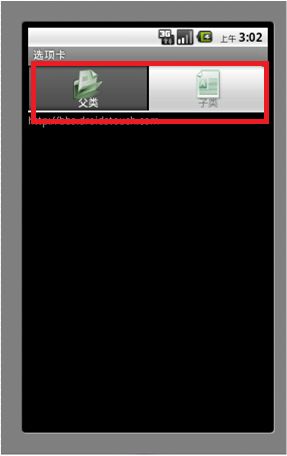Android TabHost学习笔记
一、什么是TabHost。
Android 里面的TabHost就是选项卡,看下图(新浪微博界面):
至于选项卡有什么好处或者用途,我想代码哥们都知道吧,我就不多说了。
二、在Android里面如何实现TabHost
有两种方式可以实现。
2、不继承TabActivity,然后在布局文件中定义TabHost,最后讲各个Tab选项卡添加到TabHost中
总结以上两种方式为两步:
①:获取TabHost对象
Android 里面的TabHost就是选项卡,看下图(新浪微博界面):
至于选项卡有什么好处或者用途,我想代码哥们都知道吧,我就不多说了。
二、在Android里面如何实现TabHost
有两种方式可以实现。
1、继承TabActivity,然后用getTabHost()方法获取TabHost,最后在布局文件中定义各个Tab选项卡添加到TabHost中
2、不继承TabActivity,然后在布局文件中定义TabHost,最后讲各个Tab选项卡添加到TabHost中
总结以上两种方式为两步:
①:获取TabHost对象
②:把Tab添加到TabHost中。
①:布局文件:
<?xml version="1.0" encoding="utf-8"?> <LinearLayout xmlns:android="http://schemas.android.com/apk/res/android" android:layout_width="match_parent" android:layout_height="match_parent"> <!-- 第一个选项卡面板 --> <LinearLayout android:id="@+id/tab1" android:layout_width="fill_parent" android:layout_height="fill_parent"> <!-- 面板中只有一个TextView--> <TextView android:id="@+id/V1" android:layout_width="fill_parent" android:layout_height="fill_parent" android:text="Touch Android"/> </LinearLayout> <!-- 第二个选项卡面板 --> <LinearLayout android:id="@+id/tab2" android:layout_width="fill_parent" android:layout_height="fill_parent"> <!-- 面板中只有一个TextView--> <TextView android:id="@+id/V2" android:layout_width="fill_parent" android:layout_height="fill_parent" android:text="Touch Android"/> </LinearLayout> </LinearLayout>
②:Activity
package com.droidstouch.tabhost;
import android.app.TabActivity;
import android.os.Bundle;
import android.view.LayoutInflater;
import android.widget.TabHost;
import android.widget.TabHost.TabSpec;
/**
* @author <a href="http://bbs.droidstouch.com">Touch Android</a>
*
*/
public class Demo2Activity extends TabActivity
{
protected void onCreate(Bundle savedInstanceState)
{
super.onCreate(savedInstanceState);
// this.setContentView(R.layout.demo2); // 注意不要加上此行代码
//获取到TabHost对象
TabHost tabHost =this.getTabHost();
//把我们的布局文件添加到tabHost 的FrameLayout下面
LayoutInflater.from(this).inflate(R.layout.demo2, tabHost.getTabContentView(), true);
// 下面定义了两个选项卡
//获取一个新的TabHost.TabSpec,并关联到当前tab host
//参数:所需的选项卡标签
TabSpec pSpec = tabHost.newTabSpec("parent");
// 参数一:选项卡上的文字,参数二:选项卡的背景图片
pSpec.setIndicator("父类", this.getResources().getDrawable(R.drawable.f_root));
//设置选项卡内容
pSpec.setContent(R.id.tab1);
TabSpec subSpec = tabHost.newTabSpec("sub");
subSpec.setIndicator("子类", this.getResources().getDrawable(R.drawable.f_sub));
subSpec.setContent(R.id.tab2);
// 将选项卡添加到TabHost中
tabHost.addTab(pSpec);
tabHost.addTab(subSpec);
}
}
第二种方式
①:布局文件
<?xml version="1.0" encoding="utf-8"?> <LinearLayout xmlns:android="http://schemas.android.com/apk/res/android" android:orientation="vertical" android:layout_width="fill_parent" android:layout_height="fill_parent" > <!-- 定义TabHost ,自定义的TabHost一定得包含TabWidget 和 FrameLayout, 并且 TabWidget 的ID一定是@android:id/tabs FrameLayout 的Id一定是@android:id/tabcontent --> <TabHost android:id="@+id/tabs" android:layout_width="fill_parent" android:layout_height="fill_parent"> <LinearLayout android:orientation="vertical" android:layout_width="fill_parent" android:layout_height="fill_parent" > <!-- 定义TabWidget,此控件 必须和TabHost一起使用 --> <TabWidget android:id="@android:id/tabs" android:layout_width="fill_parent" android:layout_height="wrap_content"/> <!-- 定义FrameLayout--> <FrameLayout android:id="@android:id/tabcontent" android:layout_width="fill_parent" android:layout_height="fill_parent"> <TextView android:id="@+id/txtV1" android:layout_width="fill_parent" android:layout_height="fill_parent" android:text="Touch Android"/> <TextView android:id="@+id/txtV2" android:layout_width="fill_parent" android:layout_height="fill_parent" android:text="http://bbs.droidstouch.com"/> </FrameLayout> </LinearLayout> </TabHost> </LinearLayout>
②:Activity:
package com.droidstouch.tabhost;
import android.app.Activity;
import android.os.Bundle;
import android.widget.TabHost;
import android.widget.TabHost.TabSpec;
public class Dome1Activity extends Activity {
/** Called when the activity is first created. */
@Override
public void onCreate(Bundle savedInstanceState) {
super.onCreate(savedInstanceState);
setContentView(R.layout.demo1);
//从布局文件中 获取到TabHost
TabHost tabHost = (TabHost) this.findViewById(R.id.tabs);
//安装TabHost
tabHost.setup();
// 下面定义两个选项卡
//获取一个新的TabHost.TabSpec,并关联到当前tab host
//参数:所需的选项卡标签
TabSpec pSpec = tabHost.newTabSpec("parent");
pSpec.setIndicator("父类", this.getResources().getDrawable(R.drawable.f_root));
pSpec.setContent(R.id.txtV1);
TabSpec subSpec = tabHost.newTabSpec("sub");
subSpec.setIndicator("子类", this.getResources().getDrawable(R.drawable.f_root));
subSpec.setContent(R.id.txtV2);
//添加选项卡到TabHost中
tabHost.addTab(pSpec);
tabHost.addTab(subSpec);
}
}

